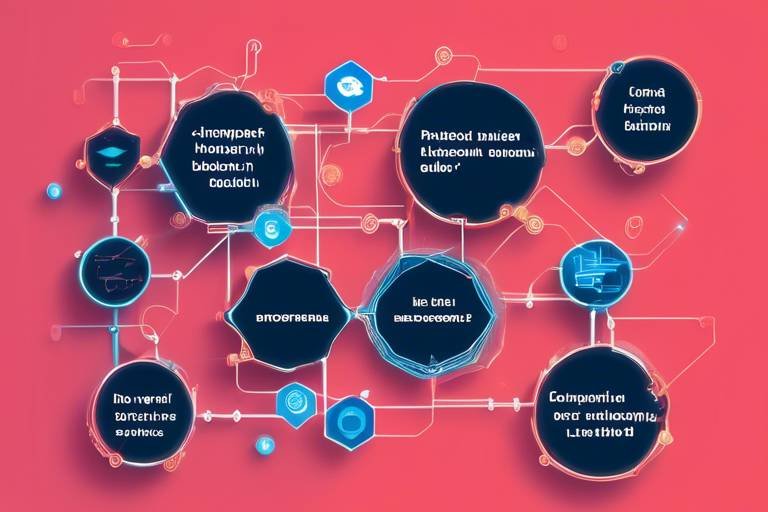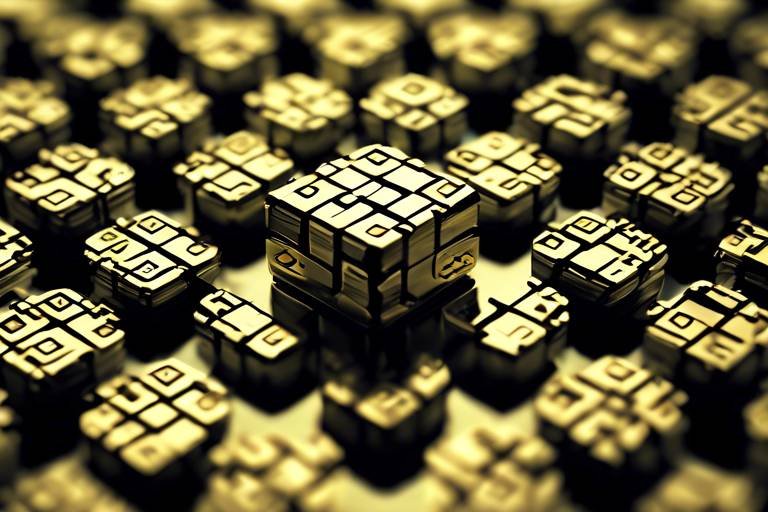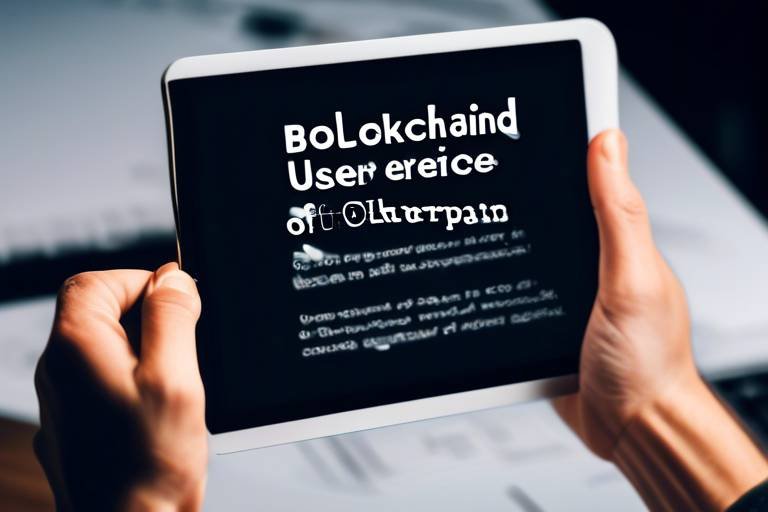The Role of Blockchain in Enhancing Digital Experience
In today's rapidly evolving digital landscape, blockchain technology is not just a buzzword; it's a game changer. Imagine a world where your online transactions are not only secure but also transparent and efficient. Sounds like a dream, right? Well, blockchain is making that dream a reality by revolutionizing how we interact with digital platforms across various sectors, including finance, healthcare, and supply chain management. This article dives deep into how blockchain enhances digital experiences, ensuring that users feel more secure and engaged than ever before.
At its core, blockchain operates as a decentralized ledger, which means that instead of relying on a single entity to manage data, it distributes that responsibility across a network of computers. This decentralization is revolutionary because it not only enhances data integrity but also reduces the risk of fraud and cyberattacks. Think of it as a digital fortress that protects your information while allowing you to interact freely and confidently online.
But how does this all play out in real life? Well, consider your typical online transaction. When you purchase something online, you often have to provide personal information and trust that the platform will keep it safe. With blockchain, that trust is built-in. Each transaction is recorded on the blockchain in a way that is immutable, meaning it can't be altered or deleted. This creates a level of trust and transparency that traditional systems simply cannot match. Users can verify transactions independently, ensuring that what they see is what they get.
However, while blockchain enhances transparency, it also raises important questions about data privacy. Users want to know that their information is secure, yet they also appreciate the transparency that blockchain offers. This creates a delicate balance that digital platforms must navigate. Striking the right balance between openness and confidentiality is crucial for fostering user confidence and engagement.
Another fascinating aspect of blockchain is the concept of smart contracts. These are self-executing contracts with the terms of the agreement directly written into code. Imagine a vending machine: you put in your money, select your item, and the machine automatically delivers it. Smart contracts work in a similar way, automating processes and eliminating the need for intermediaries. This not only streamlines operations but also significantly reduces costs, enhancing user experiences across various applications.
As we explore the applications of blockchain across different industries, it becomes clear that its impact is far-reaching. In finance, for instance, blockchain allows for faster transactions and lower fees, fundamentally changing how consumers and businesses interact with financial services. Meanwhile, in healthcare, it securely manages patient data, ensuring that information is accessible yet protected, which fosters trust among stakeholders.
Despite its immense potential, blockchain technology is not without its challenges. Issues such as scalability, regulatory concerns, and energy consumption must be addressed to fully realize its benefits. Scalability, in particular, poses a significant hurdle, as the current infrastructure can struggle to handle high transaction volumes efficiently. This can hinder widespread adoption, especially in high-demand applications.
Additionally, navigating the regulatory landscape is crucial for blockchain adoption. Different regions have varying laws and compliance requirements, which can complicate the implementation of blockchain solutions. As the technology continues to evolve, so too must the frameworks that govern it, ensuring that innovation can flourish while still protecting users.
In conclusion, blockchain technology is not just enhancing digital experiences; it's transforming them. By providing enhanced security, transparency, and efficiency, blockchain is paving the way for a future where users can engage with digital platforms with confidence. As we continue to explore its potential, it's essential to address the challenges that lie ahead, ensuring that this revolutionary technology can be harnessed to its fullest extent.
- What is blockchain technology? Blockchain is a decentralized ledger system that records transactions across multiple computers, ensuring data integrity and security.
- How does blockchain enhance security? Through features like cryptography and decentralization, blockchain provides robust protection against fraud and cyberattacks.
- What are smart contracts? Smart contracts are self-executing contracts with the terms directly written into code, automating processes and reducing the need for intermediaries.
- What industries are benefiting from blockchain? Industries such as finance, healthcare, and supply chain management are leveraging blockchain for improved efficiency and security.
- What challenges does blockchain face? Key challenges include scalability issues, regulatory concerns, and energy consumption that need to be addressed for broader adoption.

Understanding Blockchain Technology
This article explores how blockchain technology is revolutionizing the digital landscape, improving security, transparency, and user engagement across various sectors, including finance, healthcare, and supply chain management.
Blockchain technology is often described as a decentralized ledger that records transactions across many computers in such a way that the registered transactions cannot be altered retroactively. This core principle ensures the integrity and security of data, making it a game-changer in various industries. Imagine a digital notebook that everyone can see, but no one can erase or change. That's essentially what blockchain does—it creates a permanent record of transactions that is transparent yet secure.
At its heart, blockchain operates on a few fundamental principles:
- Decentralization: Unlike traditional databases that are controlled by a central authority, blockchain distributes data across a network of computers, or nodes. This means that no single entity has control over the entire database, which significantly reduces the risk of data tampering.
- Immutability: Once a transaction is recorded on the blockchain, it cannot be changed or deleted. This feature is crucial for maintaining trust among users, as it ensures that no one can manipulate the data after it has been entered.
- Transparency: All transactions are visible to participants in the network, which fosters accountability. Users can independently verify transactions without the need for a middleman.
To illustrate how blockchain operates, let’s consider a simple analogy. Think of blockchain like a public library. Each book represents a transaction, and once a book is placed on the shelf (the blockchain), it cannot be taken off or altered. Everyone can read the books, but only a select few can add new ones. This system not only keeps the library organized but also ensures that every book is accounted for and remains unchanged.
Blockchain technology is built upon a series of blocks, each containing a list of transactions. When a block is filled, it is sealed and linked to the previous block, forming a chain. This structure is what gives blockchain its name. Each block also has a unique cryptographic hash that acts like a digital fingerprint, ensuring that any attempt to alter the block would change its hash, alerting the network to the tampering.
| Feature | Description |
|---|---|
| Decentralization | No single entity controls the blockchain; it is distributed across a network. |
| Immutability | Once recorded, transactions cannot be altered or deleted. |
| Transparency | All participants can view the transactions, enhancing accountability. |
In conclusion, understanding blockchain technology is crucial for grasping its potential to enhance digital experiences. Its unique characteristics—decentralization, immutability, and transparency—set it apart from traditional systems, making it a cornerstone of trust in digital transactions. As we dive deeper into the various applications of blockchain, it becomes evident that its impact is only just beginning to unfold.
- What is blockchain technology? Blockchain is a decentralized digital ledger that records transactions across multiple computers, ensuring that the data is secure, transparent, and immutable.
- How does blockchain ensure security? Blockchain uses cryptographic techniques and decentralization to protect data from unauthorized access and tampering.
- What industries are adopting blockchain? Key industries include finance, healthcare, supply chain management, and many more, each leveraging blockchain for enhanced security and efficiency.

Enhanced Security Features
In a world where digital threats loom large, the security features of blockchain technology stand out like a beacon of hope. By leveraging advanced cryptography and a decentralized architecture, blockchain provides a robust framework that not only protects data but also enhances the overall digital experience. Imagine a vault that is both impenetrable and transparent—this is what blockchain aims to achieve in the realm of cybersecurity.
At its core, blockchain operates as a distributed ledger, meaning that instead of storing data in a central location, it is replicated across a network of computers (or nodes). This decentralization is crucial because it eliminates the risk of a single point of failure. If one node is compromised, the others remain secure, thus protecting the integrity of the entire system. This feature is particularly valuable in industries where trust is paramount, such as finance and healthcare.
Among the key enhanced security features of blockchain are:
- Immutability: Once a transaction is recorded on the blockchain, it cannot be altered or deleted. This immutability ensures that the data remains trustworthy and verifiable over time.
- Cryptographic Security: Each transaction is encrypted using complex mathematical algorithms, making it nearly impossible for hackers to tamper with the data.
- Transparency: While transactions are secure, they are also transparent. Users can view transaction histories, fostering accountability and trust among participants.
These features collectively contribute to a more secure digital environment. For instance, in the financial sector, the use of blockchain can significantly reduce the occurrence of fraud. Traditional banking systems are often vulnerable to cyberattacks, but with blockchain, the need for intermediaries is eliminated, and transactions are conducted directly between users. This direct interaction not only speeds up the process but also minimizes the opportunities for fraudulent activities.
Moreover, the decentralized nature of blockchain technology empowers users by giving them control over their own data. In traditional systems, users often have to rely on third parties to manage their information, which can lead to breaches of privacy and trust. However, with blockchain, users can transact and share data without needing to hand over control to a central authority. This shift not only enhances security but also fosters a sense of ownership and accountability among users.
While blockchain's enhanced security features are impressive, they also come with their own challenges. For instance, the transparency of the blockchain can raise concerns regarding data privacy. How do we ensure that sensitive information remains confidential while still benefiting from the transparency that blockchain offers? This balance between openness and user confidentiality is crucial as we navigate the digital landscape.
In conclusion, the enhanced security features of blockchain technology not only protect against fraud and cyber threats but also empower users by giving them control over their data. As we continue to embrace digital solutions across various sectors, understanding and implementing these security features will be vital in creating a safer and more trustworthy digital experience.
Q: How does blockchain ensure data integrity?
A: Blockchain ensures data integrity through its immutable nature; once a transaction is recorded, it cannot be changed or deleted. This is supported by cryptographic techniques that secure each transaction.
Q: What are the implications of decentralization for user security?
A: Decentralization reduces the risk of a single point of failure, meaning that even if one node is compromised, the overall system remains secure. This empowers users by giving them more control over their transactions and data.
Q: Can blockchain technology protect sensitive information?
A: Yes, while blockchain is transparent, it employs cryptographic measures to secure sensitive information. However, a balance must be struck between transparency and privacy to protect user data effectively.

Decentralization and Its Benefits
Decentralization is one of the most exciting features of blockchain technology, and it fundamentally changes how we think about data management and security. Imagine a world where no single entity holds the keys to your data, where you, the user, are in control. This shift not only enhances security but also empowers individuals, creating a more democratic digital landscape. In a centralized system, you often rely on a third party to manage your information, which can lead to vulnerabilities. However, with decentralization, data is distributed across a network of computers, making it significantly harder for hackers to compromise the entire system.
One of the standout benefits of decentralization is the reduction of single points of failure. In a traditional centralized system, if the main server goes down, the entire operation can grind to a halt. But with blockchain, even if one node fails, the rest of the network continues to function seamlessly. This resilience is akin to a spider's web—if one strand is broken, the web still holds together. This characteristic not only enhances reliability but also builds trust among users who can see that their data is safe and secure.
Moreover, decentralization fosters a sense of ownership. Users can manage their own data and transactions without the interference of intermediaries. This empowerment is crucial in an age where data privacy is paramount. When users know they have control over their information, they are more likely to engage with digital platforms. Just imagine how liberating it feels to know that your data is yours alone, not sitting in a corporate database waiting to be sold or misused.
To illustrate the benefits of decentralization, consider the following table:
| Benefit | Description |
|---|---|
| Enhanced Security | Data is stored across multiple nodes, making it nearly impossible for hackers to alter or steal information. |
| Increased Trust | Users can verify transactions independently, leading to greater confidence in the system. |
| Empowerment | Users have control over their data, reducing reliance on third parties. |
| Resilience | The network remains operational even if some nodes fail, ensuring continuous service. |
In summary, decentralization is not just a technical feature; it's a revolutionary approach that transforms how we interact with digital platforms. It enhances security, builds trust, and empowers users, making it a cornerstone of the blockchain revolution. As we move forward, embracing decentralization could lead to more innovative and secure digital experiences that truly prioritize the needs and rights of users.
- What is decentralization in blockchain? Decentralization refers to the distribution of data across a network, eliminating the need for a central authority to manage it.
- How does decentralization enhance security? By spreading data across multiple nodes, it becomes significantly harder for hackers to access or manipulate the entire system.
- Why is user empowerment important? When users control their own data, they are more likely to trust and engage with digital platforms, leading to a healthier digital ecosystem.

Trust and Transparency
In today's digital age, trust and transparency are more critical than ever. With the rise of online transactions and digital interactions, consumers are increasingly concerned about the integrity of their data and the authenticity of the services they use. This is where blockchain technology steps in like a superhero, offering a solution that not only addresses these concerns but also empowers users in ways we never thought possible. Imagine a world where every transaction is recorded in an unchangeable ledger, visible to all but tampered by none. This is the essence of blockchain.
Blockchain's architecture is designed to be decentralized, meaning that no single entity has control over the entire network. This decentralization fosters a sense of trust among users because it eliminates the possibility of manipulation by a central authority. When you engage with a blockchain-based platform, you can see the entire history of transactions, which is publicly accessible and verifiable by anyone. This level of transparency is revolutionary, especially in industries where trust is paramount, such as finance and healthcare.
To illustrate this point, consider the following table that highlights how blockchain enhances trust and transparency across different sectors:
| Industry | Trust Mechanism | Transparency Feature |
|---|---|---|
| Finance | Decentralized ledger prevents fraud | Public records of transactions |
| Healthcare | Immutable patient records | Accessible data for all stakeholders |
| Supply Chain | Verified product provenance | Real-time tracking of goods |
The implications of this transparency are profound. Users can independently verify the authenticity of transactions, which significantly reduces the risk of fraud. For instance, in the finance sector, consumers can trace their funds back to their origin, ensuring that their money is not being used for illicit activities. Similarly, in healthcare, patients can be assured that their medical records are accurate and have not been altered without their consent.
However, while blockchain promotes transparency, it also brings forth challenges regarding data privacy. Users may wonder, "How much of my information is publicly available?" This question highlights the delicate balance that must be maintained between openness and confidentiality. As we embrace this technology, stakeholders must find ways to ensure that sensitive information remains protected while still benefiting from the transparency that blockchain offers.
In conclusion, the trust and transparency fostered by blockchain technology are not just buzzwords; they represent a fundamental shift in how we interact in the digital landscape. As we continue to explore and implement blockchain solutions, we must remain vigilant about the balance between transparency and privacy, ensuring that the benefits of this technology are realized without compromising individual rights.
- What is blockchain technology? Blockchain is a decentralized digital ledger that records transactions across multiple computers, ensuring data integrity and security.
- How does blockchain enhance trust? By providing transparent and immutable records of transactions that anyone can verify independently.
- Are all transactions on blockchain public? Yes, transactions are publicly accessible, but sensitive information can be encrypted to protect user privacy.
- What industries can benefit from blockchain? Industries such as finance, healthcare, supply chain management, and many others can leverage blockchain for improved security and transparency.

Data Privacy Considerations
In the world of blockchain, where transparency reigns supreme, the question of data privacy looms large. While blockchain technology offers a transparent and immutable record of transactions, it also raises significant concerns regarding the confidentiality of personal information. Imagine a public ledger where every transaction is visible to all—this level of openness can be a double-edged sword. On one hand, it fosters trust and accountability; on the other, it can expose sensitive data to prying eyes.
To illustrate, consider the healthcare sector, where patient records are often stored on blockchain systems. While the integrity of these records is enhanced, there’s a pressing need to ensure that personal health information remains confidential. The challenge lies in finding the right balance between transparency and privacy. Organizations must implement robust encryption methods and privacy-preserving techniques, such as zero-knowledge proofs, to safeguard sensitive information while still benefiting from the advantages of blockchain.
Furthermore, the question of who has access to this data is crucial. Users should have the power to control their own information, deciding what to share and with whom. As the digital landscape evolves, implementing user-centric data privacy measures will be essential for fostering trust. A decentralized approach can empower individuals, allowing them to retain ownership of their data, but it also requires a shift in mindset for both users and organizations.
In terms of compliance, regulations such as the General Data Protection Regulation (GDPR) in Europe impose strict guidelines on how personal data is handled. Blockchain's inherent transparency can sometimes conflict with these regulations, creating a complex landscape for companies to navigate. To address these challenges, organizations need to develop strategies that align blockchain applications with existing privacy laws while ensuring that user rights are upheld.
Ultimately, the future of blockchain and data privacy will depend on continuous innovation and collaboration among stakeholders. As we explore this exciting technology, it’s crucial to remain vigilant about the implications for personal privacy. Striking the right balance will not only enhance user trust but also pave the way for broader adoption of blockchain across various sectors.
- What is blockchain technology? Blockchain technology is a decentralized digital ledger that records transactions across multiple computers, ensuring that the recorded information is secure, transparent, and immutable.
- How does blockchain enhance security? Blockchain enhances security through cryptographic techniques and decentralization, making it difficult for hackers to alter transaction data.
- What are smart contracts? Smart contracts are self-executing contracts with the terms of the agreement directly written into code, allowing for automated and secure transactions without intermediaries.
- How does blockchain impact data privacy? While blockchain provides transparency, it raises concerns about data privacy, necessitating measures to protect sensitive information while maintaining compliance with regulations.

Smart Contracts and Automation
Smart contracts are one of the most exciting innovations brought about by blockchain technology. Imagine a contract that executes itself when the conditions are met, without the need for intermediaries or manual oversight. That's exactly what smart contracts do! They are essentially self-executing contracts with the terms of the agreement directly written into code. This means that once the conditions are fulfilled, the contract automatically enforces the agreement, making transactions faster, cheaper, and more secure.
Let’s break it down a bit. When you think of traditional contracts, you often picture a pile of paperwork, signatures, and possibly a lawyer or two. Now, picture this instead: an automated process that not only reduces the time spent on paperwork but also eliminates the chances of human error. Smart contracts reside on the blockchain, which means they benefit from its inherent security and transparency. This technology ensures that once a contract is deployed, it cannot be altered, providing an unparalleled level of trust.
For example, in the real estate sector, smart contracts can streamline property transactions. Instead of waiting for a bank to process payments and transfer ownership, a smart contract can automatically transfer the deed to the buyer once the payment is made. This not only speeds up the process but also reduces costs associated with intermediaries. Here’s a quick look at how this can work:
| Step | Traditional Method | Smart Contract Method |
|---|---|---|
| 1 | Buyer and seller negotiate terms. | Buyer and seller agree on terms and write them in code. |
| 2 | Paperwork is prepared and signed. | Code is deployed on the blockchain. |
| 3 | Payment is processed through a bank. | Payment is made directly through cryptocurrency. |
| 4 | Ownership transfer is handled by a lawyer. | Ownership is automatically transferred via the smart contract. |
This level of automation not only enhances efficiency but also significantly reduces the potential for fraud. Since smart contracts operate on a decentralized network, they are less susceptible to tampering compared to traditional systems. Moreover, because the terms are clear and unchangeable, all parties involved can have peace of mind knowing that the contract will execute as intended.
However, while the benefits are substantial, it’s important to note that smart contracts are not without their challenges. For instance, they require precise coding; any errors can lead to unintended consequences. Additionally, there’s the issue of integrating smart contracts with existing legal frameworks. As we continue to explore the potential of blockchain technology, it’s crucial to address these challenges to ensure that smart contracts can reach their full potential in automating processes across various industries.
- What is a smart contract? A smart contract is a self-executing contract with the terms of the agreement directly written into code on the blockchain.
- How do smart contracts enhance efficiency? They automate processes, reducing the need for intermediaries and minimizing human error.
- Are smart contracts secure? Yes, they benefit from the security features of blockchain technology, making them resistant to tampering.
- What industries can benefit from smart contracts? Industries such as real estate, finance, supply chain, and healthcare can all leverage smart contracts for improved efficiency and security.

Applications in Various Industries
Blockchain technology is not just a buzzword; it’s a game-changer that’s making waves across various industries. From finance to healthcare, its applications are vast and transformative, enhancing digital experiences like never before. Imagine a world where transactions are not only faster but also more secure and transparent. That’s the promise of blockchain, and it’s already being realized in several fields.
In the finance sector, blockchain is revolutionizing how we handle money. Traditional banking systems often involve multiple intermediaries, leading to delays and increased costs. With blockchain, transactions can occur directly between parties, significantly reducing the time and fees associated with financial operations. For instance, cross-border payments that typically take days can be completed in a matter of minutes. This efficiency is not just beneficial for consumers; businesses are also reaping the rewards by streamlining their financial processes.
Healthcare is another area where blockchain is making a significant impact. Patient data management has long been a challenge, with issues around data silos and interoperability. Blockchain offers a solution by providing a secure, decentralized platform for storing patient records. This ensures that data is not only safe but also easily accessible to authorized parties, enhancing collaboration among healthcare providers. Furthermore, patients can have more control over their own data, deciding who can access their information, thus fostering a sense of trust and security.
Logistics and supply chain management are also seeing the benefits of blockchain technology. In an industry where transparency and traceability are crucial, blockchain enables real-time tracking of products from origin to destination. This not only helps in verifying the authenticity of goods but also in improving efficiency by reducing delays and losses. For example, companies can quickly identify where a product is in the supply chain, allowing for faster response times to any issues that may arise.
Moreover, the real estate sector is embracing blockchain to simplify property transactions. Traditionally, buying or selling property involves a maze of paperwork and intermediaries. Blockchain can streamline these processes by digitizing records and utilizing smart contracts to automate transactions. This not only speeds up the buying and selling process but also reduces the potential for fraud, making real estate transactions more secure.
To illustrate the diverse applications of blockchain across industries, here’s a quick overview:
| Industry | Application | Benefits |
|---|---|---|
| Finance | Faster and cheaper transactions | Reduced fees, improved accessibility |
| Healthcare | Secure patient data management | Enhanced privacy, interoperability |
| Logistics | Real-time tracking of goods | Improved transparency, reduced delays |
| Real Estate | Streamlined property transactions | Faster processes, reduced fraud |
As we can see, the potential of blockchain technology is vast, and its applications are continually expanding. Each industry is finding unique ways to leverage this innovative technology to enhance efficiency, security, and user engagement. The future looks bright for blockchain, and as it matures, we can expect even more groundbreaking applications to emerge, reshaping how we interact with the digital world.
- What is blockchain technology?
Blockchain technology is a decentralized digital ledger that records transactions across many computers in such a way that the registered transactions cannot be altered retroactively, ensuring data integrity and security. - How does blockchain enhance security?
Blockchain enhances security through its use of cryptography and decentralization, which protects against fraud and unauthorized access. - What are smart contracts?
Smart contracts are self-executing contracts with the terms of the agreement directly written into code, allowing for automated processes on the blockchain. - What industries are using blockchain?
Industries such as finance, healthcare, logistics, and real estate are currently adopting blockchain technology to improve efficiency and security.

Finance and Banking Innovations
In the rapidly evolving world of finance, blockchain technology is making waves like never before. Imagine a world where your transactions are not only faster but also more secure, where fees are slashed and fraud is minimized. This is not just a dream—it's the reality that blockchain is ushering into the banking sector. Traditional banking methods often involve multiple intermediaries, which can slow down transactions and inflate costs. However, with blockchain, we are witnessing a shift towards a more streamlined and efficient approach.
At its core, blockchain serves as a decentralized ledger that records transactions across numerous computers. This means that no single entity has control over the entire system, which significantly reduces the risk of fraud. For example, when you make a transaction using blockchain, it is verified by a network of computers, ensuring that it is legitimate before being added to the ledger. This not only enhances security but also fosters trust among users, as they can independently verify transactions.
Moreover, the benefits of blockchain extend beyond just security. The technology enables faster transaction times, allowing users to send and receive funds almost instantly, regardless of geographical barriers. Traditional banking systems can take days to process international transactions, but blockchain can accomplish this in mere minutes. Imagine being able to send money to a friend in another country without the hassle of waiting for days or incurring hefty fees. This is the power of blockchain in finance.
Furthermore, blockchain can drastically reduce transaction fees. By eliminating intermediaries, users can save a significant amount of money. For instance, consider a simple comparison of transaction costs:
| Transaction Type | Traditional Fee | Blockchain Fee |
|---|---|---|
| Domestic Transfer | $3-$10 | $0.10-$0.50 |
| International Transfer | $30-$50 | $1-$5 |
This table illustrates just how much consumers stand to gain from adopting blockchain technology. By lowering costs and increasing efficiency, blockchain is not just improving the user experience; it's transforming the entire financial landscape.
However, as with any innovation, there are challenges to overcome. The integration of blockchain into existing banking systems requires not only technological advancements but also regulatory compliance. Banks are beginning to explore the potential of smart contracts, which are self-executing contracts with the terms of the agreement directly written into code. These can automate various processes, further enhancing efficiency and reducing the likelihood of human error.
In conclusion, the innovations brought about by blockchain technology in finance and banking are nothing short of revolutionary. With enhanced security, reduced costs, and faster transaction times, the future of finance is undoubtedly leaning towards a blockchain-driven model. As we continue to explore these advancements, one can't help but wonder: how much more efficient could our financial systems become?
- What is blockchain technology? Blockchain is a decentralized ledger technology that records transactions across multiple computers, ensuring security and transparency.
- How does blockchain improve transaction speed? By eliminating intermediaries, blockchain allows for direct peer-to-peer transactions, significantly speeding up the process.
- Are blockchain transactions secure? Yes, blockchain transactions are highly secure due to cryptography and the decentralized nature of the technology.
- What are smart contracts? Smart contracts are self-executing contracts with the terms of the agreement directly written into code, which automate processes and reduce human error.

Healthcare Data Management
In the ever-evolving world of healthcare, managing patient data securely and efficiently is paramount. With the increasing digitization of health records, the need for a robust system that ensures privacy, interoperability, and accessibility has never been more pressing. Blockchain technology emerges as a game-changer in this domain, offering innovative solutions that enhance the management of healthcare data.
At its core, blockchain provides a decentralized and immutable ledger that can securely store patient records. This means that once data is entered into the blockchain, it cannot be altered or deleted, ensuring the integrity of patient information. Imagine a world where your medical history is not only secure but also easily accessible to authorized healthcare providers, regardless of where you are. This is the promise that blockchain holds for healthcare data management.
One of the standout features of blockchain in healthcare is its ability to facilitate interoperability. Different healthcare systems often struggle to communicate with one another, leading to fragmented patient records and inefficiencies. With blockchain, patient data can be shared seamlessly across various platforms, ensuring that healthcare providers have access to comprehensive and up-to-date information. This can significantly improve patient care, as doctors can make informed decisions based on complete medical histories.
Moreover, blockchain enhances trust among stakeholders in the healthcare ecosystem. Patients can have confidence that their data is being handled securely and transparently. For instance, when patients consent to share their data for research or treatment purposes, they can track who accesses their information and for what reason. This level of transparency is crucial in building trust, especially in an industry where data breaches are all too common.
However, the implementation of blockchain in healthcare is not without its challenges. There are critical considerations regarding data privacy. While blockchain promotes transparency, it also raises questions about how much patient information should be publicly accessible. Striking a balance between openness and confidentiality is essential. Healthcare providers must ensure that sensitive information is protected while still leveraging the benefits of blockchain technology.
In summary, blockchain technology is set to revolutionize healthcare data management by enhancing security, promoting interoperability, and fostering trust among patients and providers. As the healthcare industry continues to embrace digital transformation, the integration of blockchain could lead to more efficient, secure, and patient-centered care.
- What is blockchain technology? Blockchain is a decentralized digital ledger that securely records transactions across multiple computers, ensuring that the data cannot be altered retroactively.
- How does blockchain improve healthcare? By providing a secure and immutable record of patient data, blockchain enhances data integrity, facilitates interoperability, and builds trust among healthcare stakeholders.
- What are the challenges of using blockchain in healthcare? Key challenges include scalability, regulatory compliance, and concerns regarding data privacy and security.
- Can patients control their own data with blockchain? Yes, blockchain allows patients to have greater control over their medical records, enabling them to decide who can access their information.

Challenges and Limitations
Blockchain technology, while revolutionary, is not without its . As we dive deeper into this digital frontier, it’s essential to understand the hurdles that could impede its broader adoption and effectiveness. One of the most significant challenges is scalability. As blockchain networks grow, the volume of transactions can overwhelm the system, leading to slow processing times and increased costs. This is particularly evident in high-demand applications where speed is crucial. Imagine a bustling highway during rush hour; just as traffic jams can slow you down, so too can a blockchain network become bogged down when too many transactions are trying to pass through at once.
Another pressing concern is regulatory considerations. The regulatory landscape for blockchain is still evolving. Different countries have varying laws and compliance requirements, which can create a complex web for businesses trying to implement blockchain solutions. Think of it like trying to navigate a maze; one wrong turn can lead to significant delays and complications. Companies must stay informed about these regulations to avoid legal pitfalls that could stifle innovation and adoption.
Additionally, the environmental impact of blockchain technology cannot be overlooked. Many blockchain networks, particularly those that utilize proof-of-work consensus mechanisms, consume a substantial amount of energy. This has raised eyebrows among environmentalists and regulators alike. It’s akin to a double-edged sword: while blockchain offers enhanced security and transparency, the energy consumption associated with maintaining these networks poses a significant challenge to sustainability. As we strive for a greener future, finding a balance between technological advancement and environmental responsibility will be crucial.
Furthermore, there are data privacy considerations that need to be addressed. While blockchain enhances transparency, the very nature of its public ledger can raise concerns about user confidentiality. For instance, if sensitive information is recorded on a blockchain, how can we ensure that it remains protected? It’s a delicate balancing act; users want transparency but also demand privacy. This paradox necessitates innovative solutions to safeguard personal information while still leveraging the benefits of blockchain technology.
In summary, while blockchain holds immense potential to transform various industries and enhance digital experiences, it also faces significant challenges that must be navigated carefully. Addressing these issues will be key to unlocking the full potential of blockchain technology and ensuring its viability in the long term.
- What is the main challenge of blockchain technology?
Scalability is often cited as the primary challenge, impacting transaction speed and efficiency. - How does regulation affect blockchain adoption?
Varying laws and compliance requirements across different regions can complicate the implementation of blockchain solutions. - Is blockchain environmentally friendly?
Many blockchain networks consume significant energy, raising concerns about their environmental impact. - Can blockchain ensure data privacy?
While it offers transparency, the public nature of blockchain can create challenges for user confidentiality.

Scalability Issues
Scalability is one of the most pressing challenges facing blockchain technology today. Imagine trying to fit a growing crowd into a small room; eventually, it becomes impossible to accommodate everyone comfortably. This analogy holds true for blockchain networks as they struggle to handle an increasing number of transactions without compromising speed or efficiency. While blockchain offers a revolutionary way to conduct transactions, the reality is that many existing networks are not equipped to scale effectively as demand surges.
At its core, scalability refers to the ability of a blockchain network to handle an increasing amount of work or its potential to accommodate growth. Most current blockchain systems, like Bitcoin and Ethereum, face limitations in their transaction throughput. For instance, Bitcoin can process approximately 7 transactions per second (TPS), while Ethereum manages around 30 TPS. In contrast, traditional payment processors like Visa can handle over 24,000 TPS! This disparity highlights a significant bottleneck that could hinder the adoption of blockchain technology in high-demand applications.
To address these scalability issues, developers are exploring several solutions, including:
- Layer 2 Solutions: Technologies like the Lightning Network for Bitcoin and Plasma for Ethereum allow transactions to occur off the main blockchain, reducing congestion and increasing speed.
- Sharding: This involves splitting the blockchain into smaller, more manageable pieces (or shards). Each shard can process its transactions and smart contracts, significantly increasing overall network capacity.
- Consensus Mechanism Improvements: Transitioning from Proof of Work (PoW) to more efficient mechanisms like Proof of Stake (PoS) can enhance transaction speeds and reduce energy consumption.
However, implementing these solutions is not without its challenges. Each approach comes with trade-offs in terms of security, complexity, and user experience. For example, while Layer 2 solutions can enhance speed, they may introduce new vulnerabilities if not designed correctly. Moreover, sharding requires a level of coordination and communication between shards that can complicate the network's architecture.
In conclusion, addressing scalability issues is crucial for the future of blockchain technology. Without effective solutions, the potential benefits of blockchain—such as enhanced security, transparency, and user engagement—may never reach their full potential. As developers and researchers continue to innovate, the hope is that we will see significant advancements that allow blockchain to handle the demands of a rapidly evolving digital landscape.
- What is blockchain scalability?
Blockchain scalability refers to the ability of a blockchain network to handle an increasing number of transactions efficiently. - Why is scalability important?
Scalability is crucial because it determines how well a blockchain can perform under high demand, impacting its usability and adoption. - What are some solutions to scalability issues?
Solutions include Layer 2 technologies, sharding, and improvements in consensus mechanisms. - How does scalability affect transaction speed?
Poor scalability can lead to slower transaction processing times, which can frustrate users and hinder adoption.

Regulatory Considerations
As blockchain technology continues to evolve and gain traction across various sectors, are becoming increasingly important. The decentralized nature of blockchain poses unique challenges for regulators, who must navigate a complex landscape of varying laws and compliance requirements. This can lead to uncertainty for businesses looking to adopt blockchain solutions, as they must ensure they are operating within the legal frameworks of their respective jurisdictions.
One of the primary concerns for regulators is the potential for fraud and misuse in blockchain applications. The anonymity that some blockchain networks provide can facilitate illegal activities, such as money laundering or tax evasion. As a result, regulators are tasked with finding a balance between fostering innovation and protecting consumers from potential risks. This often leads to the development of regulations that aim to enhance transparency without stifling the growth of the technology.
Additionally, the global nature of blockchain presents another layer of complexity. Different countries have different approaches to regulation, which can create challenges for businesses operating internationally. For instance, while some nations embrace blockchain technology and create favorable regulatory environments, others may impose strict regulations that hinder its adoption. This patchwork of regulations can complicate compliance efforts for companies, as they must stay informed about the rules in each market where they operate.
To illustrate the varying regulatory approaches, consider the following table:
| Country | Regulatory Approach |
|---|---|
| United States | Mixed; some states have friendly regulations while others are more stringent |
| European Union | Developing comprehensive regulations, focusing on consumer protection and data privacy |
| China | Restrictive; heavy regulations on cryptocurrency but exploring blockchain for government use |
| Switzerland | Progressive; known for its supportive stance towards blockchain and cryptocurrency |
Moreover, the regulatory landscape is continuously evolving. As more organizations adopt blockchain technology, regulators are increasingly pressured to create clear guidelines that can accommodate innovation while ensuring consumer protection. This dynamic environment means that businesses must remain agile and proactive in their compliance strategies, adapting to emerging regulations and understanding their implications on operations.
In conclusion, navigating the regulatory considerations surrounding blockchain technology is crucial for its successful implementation. Companies must stay informed about the changing legal landscape and engage with regulators to advocate for fair and balanced policies that promote innovation while safeguarding the interests of consumers. As the blockchain ecosystem matures, the collaboration between industry players and regulators will be essential to foster a secure and thriving digital environment.
- What are the main regulatory challenges for blockchain technology? The main challenges include varying laws across jurisdictions, the potential for fraud, and the need for consumer protection.
- How can businesses stay compliant with blockchain regulations? Businesses should stay informed about the regulatory landscape, engage with legal experts, and participate in industry discussions to understand compliance requirements.
- Are there countries that are more favorable towards blockchain? Yes, countries like Switzerland and Singapore are known for their supportive regulatory environments.
Frequently Asked Questions
- What is blockchain technology?
Blockchain technology is a decentralized digital ledger that records transactions across many computers. This ensures that the recorded transactions cannot be altered retroactively, providing a high level of security and integrity.
- How does blockchain enhance security?
Blockchain enhances security through its unique features like cryptography and decentralization. By eliminating the need for a central authority, it reduces the risk of fraud and cyberattacks, making it a robust solution for securing digital experiences.
- What are smart contracts?
Smart contracts are self-executing contracts with the terms of the agreement directly written into code. They automate processes and transactions on the blockchain, ensuring that conditions are met before execution, which streamlines operations and reduces costs.
- How is blockchain used in finance?
In finance, blockchain technology facilitates faster transactions, lowers fees, and enhances security. It transforms the way consumers and businesses interact with financial services, allowing for more efficient and transparent transactions.
- What challenges does blockchain face?
Blockchain faces several challenges, including scalability issues, regulatory concerns, and energy consumption. These hurdles must be addressed to fully harness the potential of blockchain in enhancing digital experiences.
- Can blockchain ensure data privacy?
While blockchain promotes transparency, it raises important questions about data privacy. Striking a balance between openness and user confidentiality is crucial to protect sensitive information in digital interactions.
- How does blockchain improve user engagement?
By providing secure and transparent interactions, blockchain fosters trust among users. This trust enhances user engagement as individuals feel more confident in their transactions and data management.



















